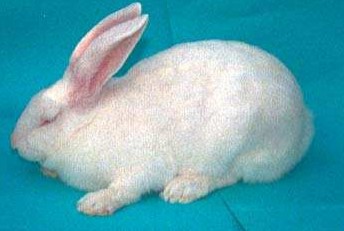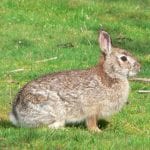Scientific Facts
| Common Name | Caldes rabbit |
| Breed Name Synonyms | IRTA’s terminal sire |
| Size & Weight | 26 cm / weighs 2.5-3.8 kg |
| Life Span | 7 – 10 years |
| Country of Origin | Barcelona Spain |

Caldes rabbits are excellent Spanish red-eyed-white meat rabbits that are well acclimated to Spain’s hot climate.
Physical Description
Rabbits are little, fuzzy animals with short fluffy tails, long ears, and large, strong rear legs. They hold 2 couples of fine, front teeth (incisors), one pair on top, and one pair on the bottom. They likewise have 2 peg teeth behind the top incisors. Their teeth are particularly modified for munching, and develop continually in the course of their lives.
Using their strong rear legs, rabbits travel by hopping. They have 4 toes on their back feet that are webbed and long to prevent them from spreading loose as they hop. Their front paws possess 5 toes each. Some species of rabbits can attain velocities of 55 to 70 kilometers per hour (35 to 45 miles per hour). Juvenile rabbits appear to walk rather than hop.
Rabbits differ in shade and measurement, varying in density from 1 to 7 kilograms (2 to 16 pounds), hinging on the breed. Pet rabbits that have been expertly guaranteed, and neutered or spayed early in life produce a life span of 8 to 12 years.
Geographical Range
The European rabbit creates the most comprehensive hole methods, called warrens. Warren burrows can be 1 – 2 meters long. The cradle at the end of the mine is filled with belly fur, grass, and moss. They practice natural tracks, which they scent impression with fecal grains.
The European rabbit is the most friendly, frequently developing groups in warrens of up to 20 exemplars. Most rabbits are comparatively alone and sometimes colonial, appearing mutually solely to reproduce or periodically to hunt in small groups.
Habitat
Rabbits are earth inhabitants that dwell in habitats extending from desert to sultry woodland and wetland. The European rabbit invades exposed landscapes such as gardens, fields, and parks. Rabbits are abundant in meadow regions where the soil enables them to obtain broad, well-drained tunnels, but likewise where there are plants or scraps of timber to provide house and protection.
Common Behavior
Rabbits like everything exactly the way they dropped them. Rabbits are victim mammals, so remembering the arrangement of the setting, particularly any possible exit paths, is a built-in ability. Don’t be shocked to witness your rabbit move around the place and backtrack his course if you’ve modified the design he is accustomed to, such as subsequent you have relocated fittings or affixed a new seat.
When a rabbit is not satisfied with something you created or with something in his surroundings, he might show his disapproval with a big “knock,” which is performed by hitting his back foot firmly toward the ground. You might catch a “blow” when you placed him back in his enclosure when he was gracefully free wandering about a place. The “blow” is frequently accompanied by the rabbit leaping away and facing his back to you, the ultimate bunny insult.
You will recognize that your rabbit loves where he is if he begins leaving a few traces of fecal rabbit beads after him as he bounces around. He might be entirely litter-trained, but he’s deciding to move outside the crate to declare his newfound colony.
Rabbits have their coat and paws neat by licking themselves constantly during the day, much similar to felines. Rabbits commonly don’t demand to be washed; however, they do require frequent stroking to lessen the volume of fur they swallow during currying. One of the cuddliest grooming positions a bunny will make is sit-up, lick and then toss his paws out karate-style and brush them toward his face.
Diet & Feeding Habits
Comprehensive, immense quantities of fresh hay must be given every day. Juvenile bunnies must be acquainted with hay as early as they can feed on their own. Timothy hay or mixed grass hay is favored since it is lower in calcium and calories than alfalfa.
Adopt a healthy quality, high fiber timothy, or alfalfa-based grain as a tiny portion of your rabbit’s nutrition.
Serve a minimum of 1 cup of legumes for every 1.8 kgs of body mass. Choose at least three varieties of vegetables regularly. A modification is essential to acquire the required nutrients, with one each day that carries Vitamin A. Append one herb to the menu at a course. Include slowly and reduce if it produces soft feces or diarrhea.
Constraint fruits to 1-2 tablespoons per 2.2 kgs of body mass (none if slimming) of high fiber fruits. Sweet fruits such as grapes and bananas must be employed merely occasionally, as exclusive feasts. Bunnies possess a sweet tooth and, if abandoned to their own means, will gorge sweet meals to the elimination of beneficial ones.
Reproduction
Animals are classified into breeding groups, promoting the control of variances between partners, lessening the increase of inbreeding. Coinciding reproductions allow a whole invasion of the enclosures and lessen the generation period.
The rate of miscarriage is 7.6. To lessen the production period does are separated after their fifth weaning, and bucks are replaced by their sons. In industrial fields, Caldes males have a long lifetime production.

How to Breed
In 1983, six series of 14 females and 2 males were hybridized on an experimental farm in Caldes de Montbui (Barcelona, Spain) subsequent an elemental coupling system, to obtain a synthetic strain with 96 does and 30 bucks (divide into 6 coupling groups).
This strain is chiefly employed as a final parent in a three-way hybridizing project. Hatchling is utilized for meat manufacture.
Natural paring is yet the most common approach. Caldes bucks are also employed in some insemination nuclei.
Rabbits commonly can reproduce at an early age, and several frequently bear litters of up to 7 juvenile, often taking so 4 or 5 times a year because a rabbit’s incubation phase is merely 28 to 31 days. Young rabbits are hairless, visionless, and helpless at parturition. Mothers are notably absent-minded to their juvenile and are relatively remote mothers, generally fostering their junior solely once per day and for plainly several minutes.
A three-way hybridizing project is suggested in rabbit breeding, to take benefit of the heterosis on generative qualities in the hybridized does, and the complementarity on germination features in the terminal hybrid employing a specific parent strain. The Caldes strain exhibits high achievements in adulthood, even at Italian or French exchange live weights.
Pet Care
Whether you choose to work with a cabin or coop, settling on a place for your rabbit is remarkably significant. Enclosures that are large enough, effortless to wash, and accessible for your rabbit to enter and exit of desire, make bestowing your roof with a rabbit so much more satisfying. An enclosure that is extensive enough is essential for the welfare of your pet rabbit, but it is likewise no replacement for adequate training and a friendly course outside of the enclosure. Litter and bedding are also critical selections to execute as the value and efficiency of the groom will be your interests over time.
Rabbits are inquisitive and jaunty and likely to flipping and tilting lightweight containers as they transfer them around and examine their breathing area. Dense ceramic pots or alloy vessels will be more difficult for rabbits to drop.
A cushiony, rabbit-secure scrub is necessary for shedding fur when your rabbit molts and safety nail clippers must be utilized for pruning a rabbit’s nails.
Rabbits demand four to five hours each day out of their box to practice, play, and mingle. For that, you’ll require a moderately huge, rabbit-proofed place. Preferably, this space is blanketed to give friction as the rabbit moves and bounce, as they can glide or skate and harm themselves on a mahogany or flooring surface.
Availability
Most pet stores trade newborn rabbits, and this is the most popular station to obtain a rabbit from, though, there are various matters to contemplate. Newborn rabbits are far more inclined to disease when newly secluded from their parent, and you can’t be particular of the sex of the rabbit. These times petshop rabbits serve to be hybrids or Dwarf or Lop-eared; regrettably, these have a greater chance of teeth problems, which will not get obvious until the rabbit is more grown.
Conservation
Status:
UK: Non-native
World: Near Threatened (IUCN Red List)
FAQs
What kind of rabbit is white with red eyes?
If you happen across a white rabbit with red eyes, you’re staring at an albino rabbit.
How many breeds of rabbits are there?
The American Rabbit Breeders Association (ARBA) presently identifies 48 bizarre rabbit breeds as of January 2016. The British Rabbit Council (BRC) currently acknowledges over 60 breeds as of August 2014.
What is a new rabbit?
A red-eyed-white (REW) rabbit possesses no color at all. It is snow white with red eyes.
Do rabbits bite?
Rabbits may bite in a more severe behavior other than snapping for consideration, however. Sometimes rabbits can be very feisty and possessive.
Do rabbits have bad eyesight?
Rabbits can detect 3-D objects, merely not as strongly as humans. Their vision range is roughly 360 degrees due to the fact their eyes are positioned high on the sides of their heads and somewhat protrude.
Why do rabbits lick you?
Nipping can likewise be done in a grooming sense. Rabbits lick for passion, not for relish. Licking signifies, “I love you; I trust you.”

